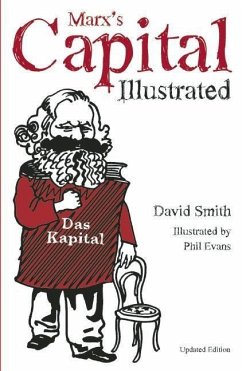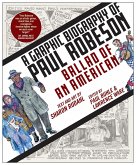- Gebundenes Buch
- Merkliste
- Auf die Merkliste
- Bewerten Bewerten
- Teilen
- Produkt teilen
- Produkterinnerung
- Produkterinnerung
This beginners guide to Capital illustrates the key concepts, humour, and immense vitality to be enjoyed in Marx's great work.
Andere Kunden interessierten sich auch für
![Red Lines: Political Cartoons and the Struggle Against Censorship Red Lines: Political Cartoons and the Struggle Against Censorship]() Cherian GeorgeRed Lines: Political Cartoons and the Struggle Against Censorship27,99 €
Cherian GeorgeRed Lines: Political Cartoons and the Struggle Against Censorship27,99 €![Ballad of an American Ballad of an American]() Sharon RudahlBallad of an American64,99 €
Sharon RudahlBallad of an American64,99 €![Unrig Unrig]() Daniel G NewmanUnrig26,99 €
Daniel G NewmanUnrig26,99 €![Best We Could Do: An Illustrated Memoir Best We Could Do: An Illustrated Memoir]() Thi BuiBest We Could Do: An Illustrated Memoir21,99 €
Thi BuiBest We Could Do: An Illustrated Memoir21,99 €![I Will Judge You by Your Bookshelf I Will Judge You by Your Bookshelf]() Grant SniderI Will Judge You by Your Bookshelf10,99 €
Grant SniderI Will Judge You by Your Bookshelf10,99 €![Jack the Ripper Illustrated Jack the Ripper Illustrated]() Gary ReedJack the Ripper Illustrated9,99 €
Gary ReedJack the Ripper Illustrated9,99 €![Dangerous Dangerous]() Milo YiannopoulosDangerous25,99 €
Milo YiannopoulosDangerous25,99 €-
-
-
This beginners guide to Capital illustrates the key concepts, humour, and immense vitality to be enjoyed in Marx's great work.
Hinweis: Dieser Artikel kann nur an eine deutsche Lieferadresse ausgeliefert werden.
Hinweis: Dieser Artikel kann nur an eine deutsche Lieferadresse ausgeliefert werden.
Produktdetails
- Produktdetails
- Verlag: Haymarket Books
- Seitenzahl: 216
- Erscheinungstermin: 4. Juli 2014
- Englisch
- Abmessung: 220mm x 144mm x 20mm
- Gewicht: 396g
- ISBN-13: 9781642593211
- ISBN-10: 1642593214
- Artikelnr.: 58460097
- Herstellerkennzeichnung
- Libri GmbH
- Europaallee 1
- 36244 Bad Hersfeld
- 06621 890
- Verlag: Haymarket Books
- Seitenzahl: 216
- Erscheinungstermin: 4. Juli 2014
- Englisch
- Abmessung: 220mm x 144mm x 20mm
- Gewicht: 396g
- ISBN-13: 9781642593211
- ISBN-10: 1642593214
- Artikelnr.: 58460097
- Herstellerkennzeichnung
- Libri GmbH
- Europaallee 1
- 36244 Bad Hersfeld
- 06621 890
David Norman Smith hails from the San Francisco Bay Area, where he received an A.B. in economics from the University of California in 1974. After earning a PhD from the University of Wisconsin-Madison in 1988, Smith joined the sociology faculty at the University of Kansas, where, from 2012-2016, he also served as department chair. Smith's many publications include Marx's Capital Illustrated (Haymarket Books, 2014, with art by Phil Evans), which has now appeared in ten languages; George Orwell Illustrated (Haymarket Books, 2018, with art by Mike Mosher); and articles on capitalism, the working class, charisma, authoritarianism, genocide, critical theory, and more in journals including Sociological Theory, Research in Political Economy, The American Psychologist, Antisemitism Studies, and Rethinking Marxism. Smith's recent publications include "The Anger Games: Who Voted for Donald Trump in the 2016 Election, and Why?" (Critical Sociology, 2018, with Eric Hanley); "Sharing, Not Selling: Marx Against Value" (Continental Thought & Theory, 2017); "Theory and Class Consciousness," in The Handbook of Critical Theory (Palgrave, 2017, edited by Michael Thompson); "Capitalism's Future," in the volume of the same name edited by Daniel Krier and Mark Worrell (Haymarket Books, 2016); "The Adventures of Professor Piketty" (Critical Sociology, 2015, illustrated by Tom Johnson); and "Charisma Disenchanted: Max Weber and His Critics" (Current Perspectives in Social Theory, 2013). A seasoned activist, Smith was named Public Citizen of the Year in 2004 by the National Association of Social Workers (Kansas) in recognition of his efforts on behalf of the successful living wage campaign in Lawrence. For Yale University Press, he is currently editing Marx's World: Global Society and Capital Accumulation in Marx's Late Manuscripts.
Introduction
1 1. Commodities
30 2. Products for Use
34 3. Alienation of Use Value
37 4. Overproduction
41 5. Exchange Value
44 6. Abstract Labour
47 7. Alienation of Useful Labor
54 8. Fetishism
57 9. Money
64 10. The Accumulation of Capital
69 11. Labor Power
86 12. Expropriation
89 13. A History Lesson
92 14. The Making of the Working Class
97 15. Surplus Value
113 16. The Rate of Surplus Value
129 17. Labour Power and Class Struggle
147 18. Abolition of Wage Labour
162
1 1. Commodities
30 2. Products for Use
34 3. Alienation of Use Value
37 4. Overproduction
41 5. Exchange Value
44 6. Abstract Labour
47 7. Alienation of Useful Labor
54 8. Fetishism
57 9. Money
64 10. The Accumulation of Capital
69 11. Labor Power
86 12. Expropriation
89 13. A History Lesson
92 14. The Making of the Working Class
97 15. Surplus Value
113 16. The Rate of Surplus Value
129 17. Labour Power and Class Struggle
147 18. Abolition of Wage Labour
162
Introduction
1 1. Commodities
30 2. Products for Use
34 3. Alienation of Use Value
37 4. Overproduction
41 5. Exchange Value
44 6. Abstract Labour
47 7. Alienation of Useful Labor
54 8. Fetishism
57 9. Money
64 10. The Accumulation of Capital
69 11. Labor Power
86 12. Expropriation
89 13. A History Lesson
92 14. The Making of the Working Class
97 15. Surplus Value
113 16. The Rate of Surplus Value
129 17. Labour Power and Class Struggle
147 18. Abolition of Wage Labour
162
1 1. Commodities
30 2. Products for Use
34 3. Alienation of Use Value
37 4. Overproduction
41 5. Exchange Value
44 6. Abstract Labour
47 7. Alienation of Useful Labor
54 8. Fetishism
57 9. Money
64 10. The Accumulation of Capital
69 11. Labor Power
86 12. Expropriation
89 13. A History Lesson
92 14. The Making of the Working Class
97 15. Surplus Value
113 16. The Rate of Surplus Value
129 17. Labour Power and Class Struggle
147 18. Abolition of Wage Labour
162








